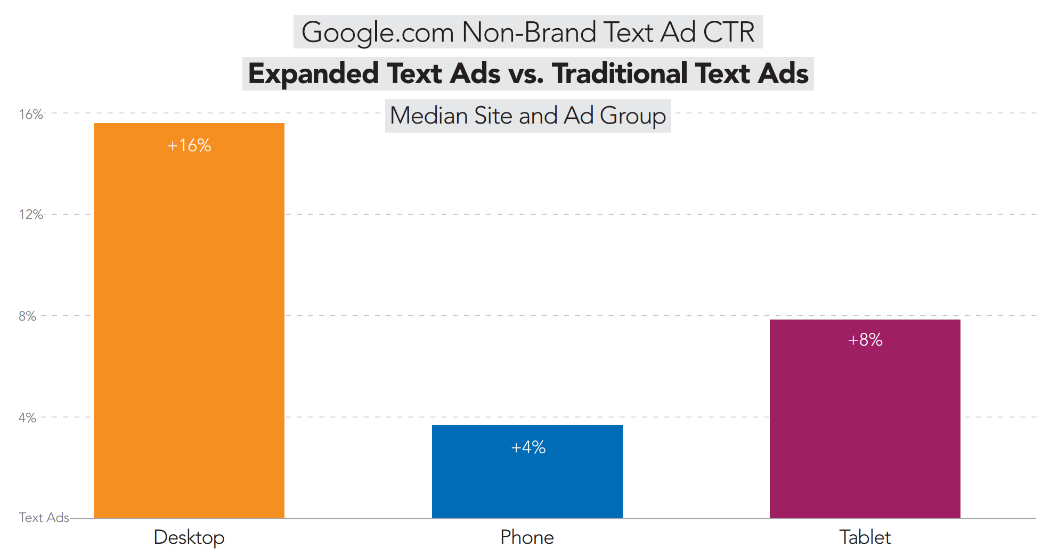Two weeks ago, Google made an announcement that they were implementing` one of the biggest changes in their text ads in over a decade. After a Beta phase starting earlier this year, expanded text ads (ETAs) are now the standard for every AdWords user as of July 26th. The previous ad format won’t be able to be created after October 26th, however, Google did not announce yet when it will be removed completely. Until further notice, both ad types will be running alongside each other. This change in ad format is a great opportunity for advertisers and there’s already some helpful advice about how to take advantage of it.
Expanded text ads vs. standard ads
Instead of the previous 25-35-35-character format that we all have been used to for years, expanded text ads appear in a 30-30-80-character scheme. Additionally, the domain for the display URL will be automatically extracted from the final URL and can be complemented with two 15-character path fields. Since this is the first change in the text ad format in AdWords in over15 years (yes, really!), this is actually quite a big thing! The new ad type is obviously much bigger, but considering the removal of the right hand side ads on the search results page earlier this year, there is more than enough space available now.
Expanded text ads are for a mobile-first world
The main purpose of this change is to serve new requirements in a mobile first world. According to Sridhar Ramaswamy, Senior Vice President Ads and Commerce at Google, mobile users want to know exactly what you offer before tapping on your website. More available characters simply mean better messaging and more information for the user to decide if your ad is worth a click. From an advertiser’s perspective, there are more opportunities to deliver the right message about your product or service and tailor it to your target audience. As a result of this, the final ad including two headlines, a long description plus display URL appear 47% bigger than the previous standard ads.
Early tests show mixed results
Early testing in the Beta phase of ETAs showed a 16% increase in click-through-rate (CTR) for non-branded text ads on desktop, 8% increase on tablets and 4% on mobile. Branded text ads did not show any significant growth in their CTR. These results appeared in Merkles Q2 Digital Marketing Report, however, need to be valued carefully since little is known about auction conditions for ETAs and the environment in which these ads were tested. Previous testing here at Reef show similar mixed results: with some variations of ETAs doubling or even tripling their CTR’s, while others did not bring any changes at all.
How to make the most of expanded text ads
The restructuring raises some challenges for marketers and for most of us this is not a project that can be completed within the next few weeks. However, certain early best practices can support and accelerate the transformation from old to new:
- Don’t just add a new line – re-think your message. Try to not just expand your previous standard ad, but take this opportunity to evaluate the message you want to deliver to your customers. Describe your product or service’s benefits and values instead of just trying to fill up the space.
- Use all available characters. Obvious, yet extremely important. Google gives you the space so use it. Your competitors will be, trust me.
- Use the path fields. While the domain is automatically extracted from the final URL, you can optionally fill out two 15-character path fields. This will give the user an additional hint about the page he/she is going to land on. It should demonstrate that your landing page is relevant, so make sure you include your top keywords!
- Focus on the headlines. The headlines are still the top eye catcher in your ad so despite the longer description, the headlines are the first lines a user will scan, so make sure your message is clear.
- Update your ad extensions. The new size of your ads plus all available ad extensions will make your ad look extremely big. However, check your current sitelinks, callouts and so on to make sure you don’t have the same content in your ad text and in the extensions. Once again, use this feature to give additional information to your audience.
- Test your new ad copies. The last and probably most important advice about ETAs is to use best practices from the Beta phase and test as much as you can. Since this is a completely new feature, it might be misleading to rely on best practices of the old standard text ads. Take your time to develop different types and styles of ads and collect enough performance data until you are able to draw valid conclusions about what works best for you.
Keeping the above in mind will help you to make the most of this new feature. However, as with everything new in the digital world, some patience and a lot of testing is essential to get the best results. If you need any support, get in touch with me and the Reef team!


